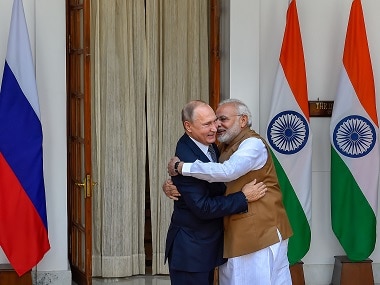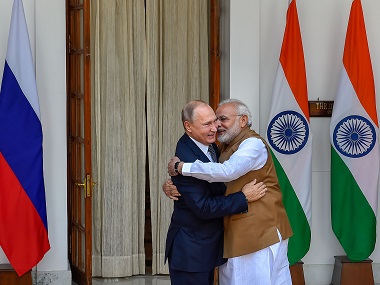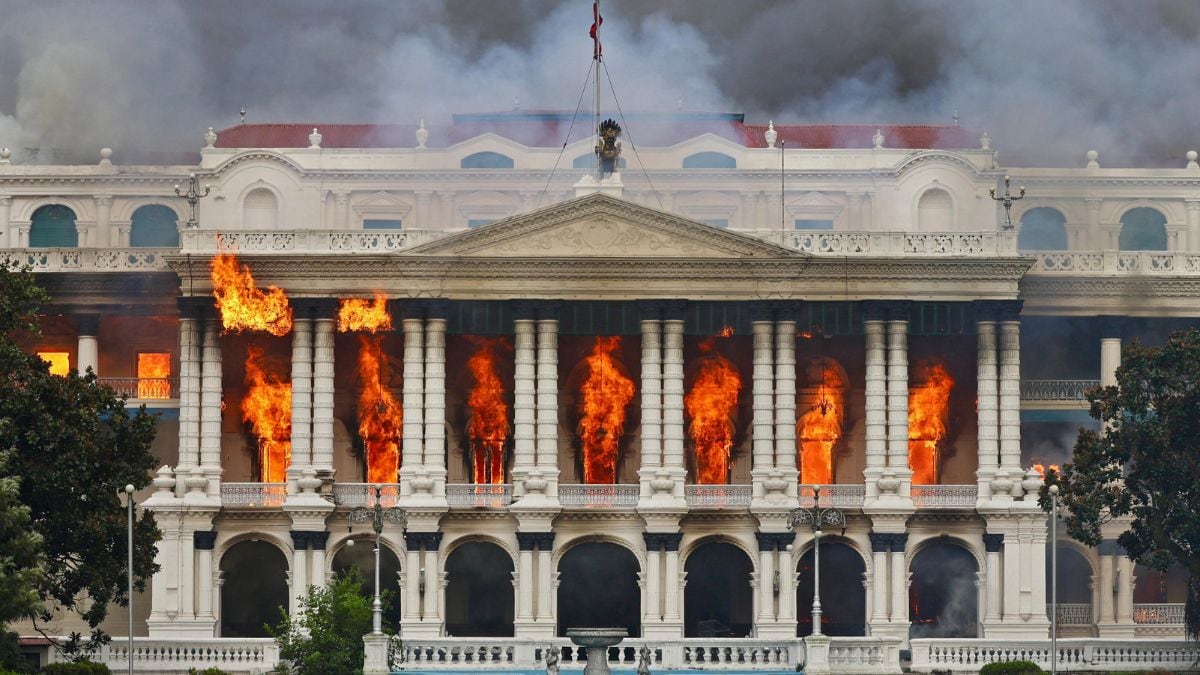Prime Minister Narendra Modi is visiting Russia for the annual bilateral summit with the Russian president Vladimir Putin. He will be in Vladivostok as the chief guest at the Eastern Economic Forum. Modi’s visit comes at a time of huge geopolitical turbulence when the US-China trade war is in full swing, the ties between two American allies – South Korea and Japan – are strained, Beijing is pursuing aggressive policies in the South China Sea, China is set to crush Hong Kong’s democracy campaign by military means, and most importantly, India-Pakistan bilateral ties are at an all-time low. India’s relationship with Russia is multi-faceted; it encompasses all major dimensions of high politics such as defence, energy, space and nuclear. The Modi-Putin meet will be their third this year as they have already met on the sidelines of the Shanghai Cooperation Organisation (SCO) summit in Bishkek and the G-20 meeting in Osaka. Putin will also host a special dinner for Modi in the backdrop of the 20th edition of annual bilateral summits which had begun in 2000. During Modi’s meeting with Putin, both countries are likely to sign two dozen pacts on defence, trade, investments, industrial cooperation, energy and connectivity corridors. Besides, India is also expected to ink a military logistics pact with Russia of the kind that Delhi has already signed with the US and France. Modi’s visit also underlines the reality that Delhi continues to regard Russia as indispensable for its larger geopolitical interests. Despite the slump in bilateral trade, political ties between the two traditional friends remain relatively warm. Now, there is a bilateral determination to ensure that trade volume between the two countries touches $30 billion mark by 2025. [caption id=“attachment_5325481” align=“alignleft” width=“380”]  Prime Minister Narendra Modi with Russian president Vladimir Putin. PTI[/caption] Nuclear-armed and expansionist in its designs, China continues to remain the biggest headache for Indian foreign policy establishment due to its intention and capability to upset Asia’s balance of power. As Asia’s geopolitical landscape is going to be determined by the policies of the US, China, India, Japan and Russia, what role will be played by China constitutes India’s greatest strategic challenge for the foreseeable future. This reasoning is behind India’s determined push to have cordial relations with Russia since the China factor has always been a key to New Delhi’s strategic ties with Moscow. With India struggling to counter threats from a revisionist China, New Delhi’s continuing efforts to contain fall out from the misadventures of the China-Pakistan nexus find echoes in its strategic thinking. Let’s try to understand it. During the Cold War period, the geopolitics of the South Asian region had strengthened bilateral relations between India and the Soviet Union. While New Delhi viewed the Soviet Union as a balancer at that time, no real need was felt to have more balancers vis-à-vis China. But the end of the Cold War changed the architecture of South Asian balance of power. The last three decades have seen a new dynamic in the region marked by the gradual emergence of India as a major regional power, remarkable improvement in India-US relations, breakdown of the US-Russian entente, the embrace between Russia and China, as well as Moscow’s new enthusiasm for Islamabad. Although the growing proximity between Moscow and Beijing is often attributed to the Western sanctions, the Russia-China entente is a post-Cold War phenomenon. Because Russia was struggling with serious socio-economic challenges that had arisen during the transformation of its political system after the disintegration of the USSR, it agreed to asymmetrical cooperation with the Western world. But as the Boris Yeltsin era gave way to the Putin era, the pro-West orientation in Moscow began to change as well. Meanwhile, the urge in Russia and China to balance the US increased following the 1999 Kosovo war and the 2003 invasion of Iraq. When second enlargement of the NATO took place in 2004, including three former Soviet republics – Lithuania, Latvia, and Estonia – and then the European Union also expanded to include Poland, the Czech Republic, Slovakia, Hungary, Slovenia, Lithuania, Latvia, and Estonia, Putin and his advisors had few doubts that the Western world was engaged in encroaching Russia’s geopolitical space. Following the 9/11 attacks, Putin had closely aligned his country with the US in Afghanistan as he wanted Russia to become America’s most important ally. This caused a great deal of concern in Chinese policy circles. But once Putin decided to change direction and hold back the Western expansion in the post-Soviet countries, it was the end of a short-lived US-Russian honeymoon. China was just waiting for this moment. The reasons behind Russia’s close strategic ties with China are also compelling. As two large neighbours, they have economic complementarities and political convergences. China’s insatiable need for natural resources and military technologies are irresistible magnates for an economically weaker Russia. The settlement of Russia-China long-standing border dispute in 2005 further paved the way for a broader relationship. But that is not the end of the story. China’s unprecedented rise has been traditionally viewed with caution in Moscow. Russia, which is seeking to regain its status as a great power, sees China as a potential strategic challenger. Therefore, reinventing and reinvigorating the Indo-Russian relationship is an important task facing the political leadership in both Delhi and Moscow. Although, Russia has been supportive of China’s Belt and Road Initiative (BRI), and there are concrete plans to link the BRI to the Moscow-driven Eurasian Economic Union (EAEU), it should not be forgotten that even at the time of the announcement of the Chinese initiative in 2013, Kremlin perceived it as a challenge to the EAEU as well an attempt to pull the Central Asian republics away from Russian sphere of influence. However, Moscow’s changed attitude is largely driven by the need to derive maximum political and economic benefits at a moment of its heightened geopolitical tensions with the US. Moscow has been trying to rebuild Russia’s influence in the region that once formed part of the Soviet Union, particularly Central Asia. But China’s ambitious geopolitical initiative poses a significant threat to Russian interests. Russia’s establishment of the EAEU can be interpreted as a way of blocking the influence of the West in Eastern Europe and China in Central Asia. Although Russia has tried to engage other actors either through a formal dialogue or through the synchronisation with other projects, the divergence of Russian and Chinese views regarding Eurasian regional order will not be easy to reconcile. New Delhi is not unaware of this dynamic. That is why the Modi government has stepped up its efforts to get Indian investment into Russia’s Far East bordering China. Commerce Minister Piyush Goyal was recently in the Russian Far East accompanied by the chief ministers of Goa, Gujarat, Haryana and Uttar Pradesh to explore such possibilities. The disintegration of the Soviet Union had seen a sharp decline in Russia’s military exports as several major clients for its weapons such as the former Warsaw Pact members disappeared. Coinciding with this development, China was seriously modernising its armed forces and acquiring advanced weaponry. The survival of Russia’s arms industry was greatly ensured due to its exports of newly produced combat aircraft, armoured vehicles and warships to China and India during this period. But the sale of advanced weapons to China was not smooth as there were many warnings that Russia would be arming a future rival. Concerns were also expressed that China would stealthily copy whatever Russia delivered. However, China’s willingness to buy a variety of weapons and its enhanced ability to pay in cash silenced all critics. Nevertheless, India and Russia also share robust defence ties as Delhi remains Moscow’s biggest arms customer; India operates many Russian-made weapon systems such as the T-90 military tanks, the MiG-29 and Su-30MKI fighter planes. India is soon going to acquire the S-400 air defence missile systems despite the huge risk of American sanctions under the CAATSA. The deal is often seen in Delhi as a sign of India’s determination to maintain its strategic autonomy while building on its strong defence ties with Russia. Similarly, India’s rising ambitions to protect its interests in the Indian Ocean and to play the role of a regional maritime power have also been partly supported by the Russians, as demonstrated in particular by India’s possession of the only operational carrier, the 45,000-ton INS Vikramaditya – the ex-Soviet carrier Admiral Gorshkov. Now, there are hopes of India being offered conventional submarines on the government-to-government route during Modi-Putin talks at Vladivostok. There is no doubt that Russia has achieved a lot during the Putinist era, which rests on the pillars of natural resources, selective memory of the Soviet victory in the Second World War, centralisation of executive power, and prominence to national sovereignty. Russia, which at the end of the previous century had almost been written off as a global power, returned to the global arena in less than two decades as one of the most active and assertive geopolitical actors. In fact, when military operations began in Syria in 2015, Russia occupied a unique position as a player that could maintain a working relationship and contacts with all the relevant players in the region. Can Modi’s India afford to ignore Putin’s Russia which is trying hard to acquire great power status? Nevertheless, Putin is not completely blind to China’s growing economic and political influence in Central Asia. That is why Putin is always trying to rebalance Russia’s relationship with China. India prominently figures in Russia’s geopolitical schemes as part of RIC (Russia-India-China) and the SCO. Under Putin, Russia considers itself as the centre of its bilateral security partnerships with India and China that could be used to counter American influence in the areas of mutual concern. In order to promote greater understanding between India and China, it was a Russian initiative to form the trilateral of the defence ministers of India, Russia and China to explore security cooperation architecture. Putin has recently suggested a more extensive economic partnership involving the EAEU, China, India, Pakistan and Iran. Even if purely economic, this particular project seems fundamentally incompatible to implement. As the world is becoming more competitive and contested, putting existing global rules and institutions under severe strain, Indian diplomacy faces many challenges. The most consequential challenge for India is the growing power, wealth and influence of China. China’s anti-India posture, as reflected in Beijing’s aggressive stance over the boundary dispute, opposition to India’s membership of the Nuclear Suppliers Group, unconstrained implementation of the China Pakistan Economic Corridor (CPEC) despite India’s sovereignty concerns, and uncritical support to Pakistan, is primarily driven by Chinese desire to exercise unchallenged supremacy over South Asia. Between India and Russia, there are some specific areas of convergence, and meeting of minds can be witnessed in many forums such as the BRICS and the SCO. But areas of divergence and disagreement are worrying signs. Not to mention Russia’s interference in Ukraine and Georgia, the Putin regime has also made many serious mistakes in South Asia. Even many Russian observers are not particularly happy with Moscow’s neglect of its ties with New Delhi, which they feel is not good for Russian foreign policy interests. In his long column published in the Moscow Times on 27 August on Putin’s foreign policy performance, Dmitry Trenin, a well-known Russian expert, has argued that “Russia has not yet been able to reboot its partnership with India. The stagnation of relations between Moscow and Delhi, which began with the collapse of the USSR, goes on. The level of Russian cooperation with India, whose economic might and international ambitions are growing rapidly, is falling further and further behind the level of interaction with China. In combination with the significant weakening of relations with the EU, this creates a threat to Russia’s geopolitical equilibrium in Greater Eurasia.” While the consequences of Russia’s outreach to Pakistan have been both symbolic and substantive, Moscow knows the limits it cannot afford to cross. That is why Russia has chosen to support India’s position on the revocation of Article 370 of its Constitution, and argued that India and Pakistan need to sort out the outstanding issues between them through dialogue. However, the drift of Moscow towards the strategic embrace of Beijing is a challenge that needs to be addressed at the earliest. Russia playing second fiddle to China in those multilateral institutions that promote China’s interests is not something that India can easily afford to ignore. As the conflict in Afghanistan comes a full circle with the imminent US-Taliban peace deal, New Delhi will need to manage its foreign policy more astutely, especially given Moscow’s growing proximity to Islamabad. It is difficult not to acknowledge the weakness and vulnerability of India’s geopolitical position vis-à-vis China-Pakistan nexus during the time of America’s imminent retreat from Afghanistan. With this in mind, not only will India have to strike a balance in its ties with Washington and Moscow, but this balancing will also need to factor into Beijing’s creeping inroads into the Indian subcontinent.
India prominently figures in Russia’s geopolitical schemes as part of Russia-India-China and the Shanghai Cooperation Organisation.
Advertisement
End of Article


)

)
)
)
)
)
)
)
)



